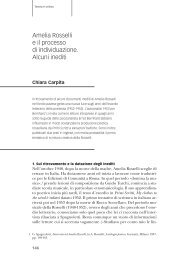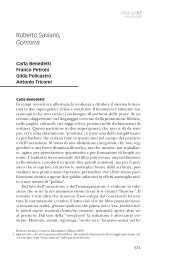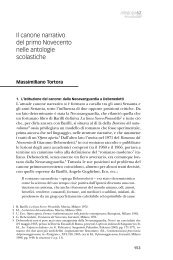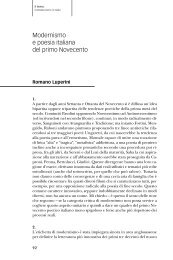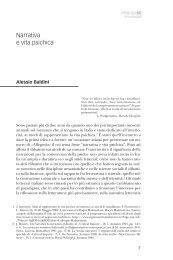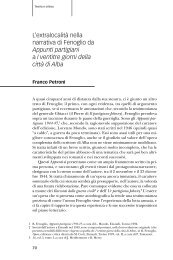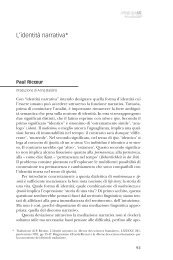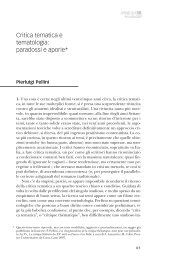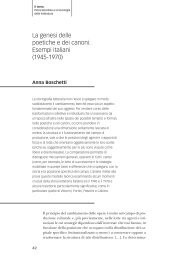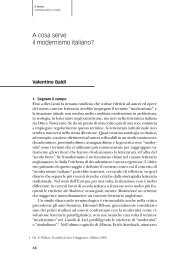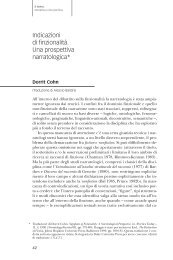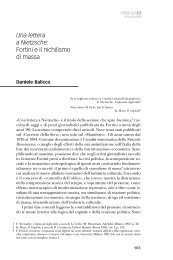Quadri per una storia del concetto di modernismo - Allegoria
Quadri per una storia del concetto di modernismo - Allegoria
Quadri per una storia del concetto di modernismo - Allegoria
Create successful ePaper yourself
Turn your PDF publications into a flip-book with our unique Google optimized e-Paper software.
allegoria63<strong>per</strong> un riorientamento degli stu<strong>di</strong> modernisti che andasse oltre il canone<strong>del</strong>lo high modernism e <strong>del</strong>l’avanguar<strong>di</strong>a continentale. In primo luogo, appareormai consolidata la tendenza a considerare il <strong>modernismo</strong> come<strong>per</strong>iodo storiografico <strong>di</strong> portata europea 55 i cui confini cronologici si situanotra secondo Ottocento e Seconda Guerra Mon<strong>di</strong>ale. 56 In secondoluogo, le prospettive teoriche che pongono al centro <strong>del</strong>l’indagine criticail contesto storico e sociale <strong>del</strong>la produzione letteraria – teoria femminista,cultural stu<strong>di</strong>es, stu<strong>di</strong> postcoloniali, queer stu<strong>di</strong>es – hanno introdotto <strong>una</strong>serie <strong>di</strong> nuovi oggetti d’indagine e prospettive metodologiche. Il progettodei “nuovi modernismi” si sviluppa secondo due <strong>di</strong>rettive, ben riassunteda Douglas Mao e Rebecca L. Walkowitz nella introduzione alla raccolta<strong>di</strong> saggi Bad Modernisms: «one that reconsiders the definitions, locations,and producers of “modernism” and another that applies new approachesand methodologies to “modernist” works». 57I «nuovi approcci e le nuove metodologie» a cui fanno riferimento idue critici hanno effettivamente <strong>per</strong>messo <strong>di</strong> ripensare secondo prospettiveine<strong>di</strong>te i “mostri sacri” <strong>del</strong> <strong>modernismo</strong>: tipico il caso <strong>di</strong> Eliot, stu<strong>di</strong>ato,fra l’altro, in termini <strong>di</strong> gender stu<strong>di</strong>es, 58 in rapporto alla cultura popolare, 59e in relazione all’anti-semitismo primonovecentesco. 60 La cosiddetta “svoltastorica” negli stu<strong>di</strong> letterari <strong>di</strong> inizio millennio ha poi favorito lo stu<strong>di</strong>o<strong>del</strong>la cultura materiale e <strong>del</strong> contesto storico-sociale <strong>del</strong> <strong>modernismo</strong>. 61Queste ricerche sono spesso caratterizzate da un eclettismo metodologicoche unisce sofisticatezza teorica e sensibilità <strong>per</strong> la micro<strong>storia</strong>, <strong>per</strong> la ricostruzionedettagliata degli angoli più recon<strong>di</strong>ti <strong>del</strong>la cultura <strong>del</strong> <strong>modernismo</strong>.O<strong>per</strong>e come il volume miscellaneo Marketing Modernism, a cura<strong>di</strong> Kevin J. Dettmar e Stephen Watt, e The Institutions of Modernism, <strong>di</strong> Law -rence Rainey, hanno ad esempio sfatato il mito <strong>del</strong>l’o<strong>per</strong>a modernista comeatto <strong>di</strong> creazione pura e <strong>di</strong>sinteressata, olimpicamente aliena da preoccupazioni<strong>di</strong> carattere economico e mercantile o anche <strong>di</strong> semplicesuccesso <strong>di</strong> pubblico, <strong>di</strong>mostrando come in effetti la sua stessa <strong>di</strong>fficoltàDagli “uomini<strong>del</strong> 1914” alla“planetarietà”.<strong>Quadri</strong> <strong>per</strong> <strong>una</strong><strong>storia</strong> <strong>del</strong><strong>concetto</strong> <strong>di</strong><strong>modernismo</strong>55 Particolarmente importante a questo riguardo è il quadro tracciato da Peter Nicholls in Modernisms.A Literary Guide, University of California Press, Berkeley-Los Angeles 1995.56 Il mandato <strong>del</strong>la MSA è in<strong>di</strong>cativo <strong>di</strong> questa visione: «The Modernist Stu<strong>di</strong>es Association isdevoted to the study of the arts in their social, political, cultural, and intellectual contextfrom the later nineteenth-through the mid-twentieth century» (http://msa.press.jhu.edu/index.html;consultato il 7 giugno 2011).57 D. Mao, R.L. Walkowitz, Introduction: Modernisms Bad and New, in Bad Modernisms, a cura <strong>di</strong>D. Mao e R.L. Walkowitz, Duke University Press, Durham 2006, p. 1.58 Gender, Desire, and Sexuality in T.S. Eliot, a cura <strong>di</strong> C. Laity e N. Gish, Cambridge UniversityPress, Cambridge 2004.59 D. Chinitz, T.S. Eliot and the Cultural Divide, University of Chicago Press, Chicago 2003.60 A. Julius, T.S. Eliot, Anti-semitism, and Literary Form, Cambridge University Press, Cambridge1995, intorno al quale è sorto un acceso <strong>di</strong>battito (cfr. i due numeri speciali <strong>di</strong>«Modernism/Modernity», X, 1 e 3, 2003, su Eliot e l’anti-semitismo).61 Cfr. P. Caughie, Time’s Exception. Response to Hilary Thompson, in Modernism and Theory, a cura<strong>di</strong> S. Ross, cit., p. 99.23



